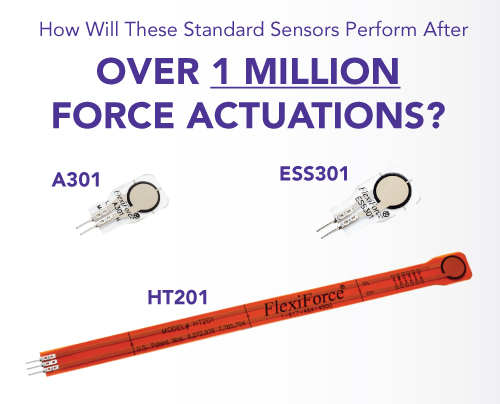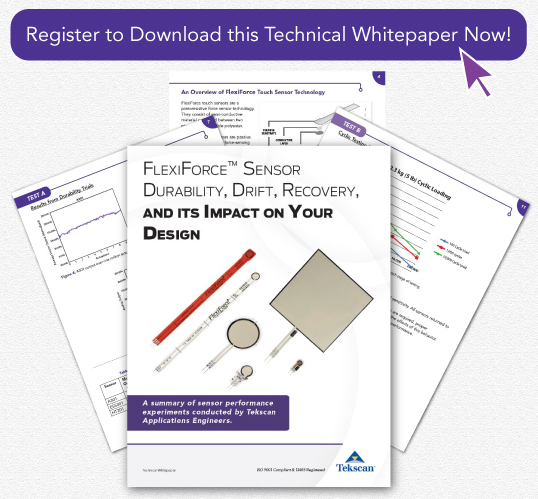We Put FlexiForce Sensors Through Our Most Rigorous Durability Test Yet; Guess What Happened...
 No matter if your force-sensing application will endure more than a million actuations or just a few touches over its service life; validating sensor durability is a long and costly process for OEMs. One of the inherent values of using force-sensitive resistor technologies in an embedded application (like FlexiForce™ touch sensors), are their thin and flexible form factors. However, one may assume that the ultra-thin properties of this force sensor type mean that it may not stand up to the rigors of high-volume loading cycles.
No matter if your force-sensing application will endure more than a million actuations or just a few touches over its service life; validating sensor durability is a long and costly process for OEMs. One of the inherent values of using force-sensitive resistor technologies in an embedded application (like FlexiForce™ touch sensors), are their thin and flexible form factors. However, one may assume that the ultra-thin properties of this force sensor type mean that it may not stand up to the rigors of high-volume loading cycles.
Therefore, we put our sensors through their most extreme testing parameters to date in order to help you make a better-informed decision on whether FlexiForce touch sensors will be right for your application.
Our new technical whitepaper titled “FlexiForce Sensor Durability, Drift, Recovery, and its Impact on Your Design” provides a summary of these two sensor performance experiments conducted by Tekscan applications engineers:
- FlexiForce sensor durability assessment following one million force actuations under extreme testing parameters, and
- FlexiForce sensor recovery evaluation following 10,000 actuations
Following these experiments, sensors were evaluated for linearity and any change in sensitivity.
While the results from the durability and recovery trials are not absolute across every possible FlexiForce sensor that Tekscan manufacturers, this document provides the typical representation of sensor longevity as an embedded component in a high force-actuation application.
Here’s a Sneak Preview into One of the Experiments:
Summary: Three different FlexiForce standard sensor models (A301, ESS301, and HT201) were normally actuated with a 2.3 kg (5 lb) load over one million times using a pneumatic air cylinder testing fixture. All sensors were driven using a non-inverting op amp circuit (single source). The loading profile and schematic went as follows:
- Sensors were preconditioned 120% of the test load (2.7 kg (6 lb) for 20 seconds, twice)
- 5up step profile to 2.3 kg (5 lb) with a 10-second dwell at each step
- 2.3 kg (5 lb) load applied at 1 Hz, 50% duty cycle for 100,000 actuations
- 5up step profile to 2.3 (5 lb) with a 10-second dwell at each step
- 5 minute rest with no load
- 5up step profile to 2.3 (5 lb) with a 10-second dwell at each step
- Steps 3-7 were repeated until one million total actuations were reached
Following the experiments, each sensor was evaluated against Tekscan’s published performance expectations for linearity error (< ±3% of Full Scale (Line drawn from 0 to 50% load)) and changes in sensitivity.
Interested in Reading the Results? Click Here to Download the Whitepaper Now!

